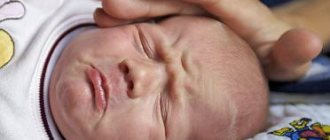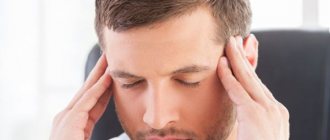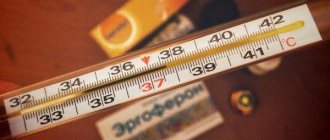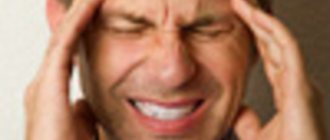Useful articles
Abuse or “rebound” headache is a pathology caused by the abuse of analgesics. It is the negative effect of drug treatment that is often detected in patients who complain of constant (daily) cephalgia. Treatment involves, first of all, stopping the uncontrolled use of painkillers and ergotamine.
Causes
The development of this type of cephalgia is caused by the abuse of analgesics, NSAIDs, triptans, serotonin agonists and ergotamine, in which the so-called “reverse effect” develops. Pathology develops when taking painkillers for at least 15 days a month, if taken for 3 months or more. This constant headache may appear after a few weeks, but usually only after several years of uncontrolled self-medication. When using over-the-counter painkillers, it begins on average after 4.7 years; for triptans, the time period is reduced to 1.7 years. Around the world, about 4% of the population suffers from headaches. It occurs twice as often in women as in men.
It is very dangerous to take mixed drugs - drugs containing one or more active substances acting on the peripheral nervous system, and one or more components acting on the central nervous system (especially caffeine or codeine). Unfortunately, such drugs are very popular among the population, but the body can get used to them. Subsequently, refusal of painkillers and psychostimulants provokes autonomic disorders. Patients, along with abusive headaches, experience increased sweating, nausea, and other symptoms of withdrawal.
Important: it is known that self-medication with analgesics for diseases not associated with cephalalgia does not lead to the development of the opposite effect.
Read also
Trigeminal neuralgia
Trigeminal neuralgia is a chronic disease characterized by excruciating paroxysmal shooting pains in the area of innervation of one or more branches of the trigeminal nerve.
Neuralgia… Read more
Monoclonal antibodies against migraine
About 11% of people in the world suffer from migraines, and a third of them are forced to stay in bed during attacks. This significantly reduces the quality of life: it interferes with work, communicating with friends and engaging in hobbies.…
More details
Cluster headache
One of the types of primary cephalgia is cluster headache ("cluster" - "bundle"). This type of cephalalgia is characterized by very intense, short attacks concentrated around the eye...
More details
Planning pregnancy in patients with migraine
In recent years, many women suffering from migraine have turned to the prevention and treatment of migraine during pregnancy. Conscious responsibility for one’s health, the desire to reproduce healthy…
More details
Tension headache
Tension headache (TTH) is one of the most common types of headache that periodically occurs in anyone, even an absolutely healthy person. It does not pose a serious threat to...
More details
Symptoms
The intensity of discomfort may vary depending on the time of day; As a rule, the pain syndrome is mild or moderate, diffuse or having a fronto-occipital localization. Painful sensations are present immediately after a person wakes up. The nature of cephalgia is dull, bilateral, pressing. It tends to significantly intensify when the usual use of analgesics is stopped, as well as during mental or physical stress. Conventional painkillers become ineffective and their duration of action is reduced.
In addition to persistent headaches caused by drugs (especially mixed analgesics), additional side effects may appear: disorders of the gastrointestinal tract, hematopoietic and renal systems. These disorders often only become apparent after years of regular abuse. The most dangerous complication from the renal system is analgesic anepropopathy with papillary necrosis and interstitial nephritis. Their development is indicated by aseptic leukocyturia, hematuria, cylindruria, proteinuria and disturbances in the ability to concentrate.
Headache and mental disorders are one of the most relevant interdisciplinary areas today. The relationship between mental disorders and headaches is extremely multifaceted; there are common mechanisms for the development of these diseases, as well as diagnostic and therapeutic approaches.
Emotional and affective disorders such as anxiety and depression are comorbid with many forms of primary headaches, but have been particularly studied in migraine. These disorders not only aggravate the course of migraine, but are also proven factors in its chronicity. Addictive behavior and anxiety disorders underlie the development of abuse of painkillers for headaches (abusive headaches). Finally, a group of secondary headaches associated with mental disorders has been identified (Chapter 12 of the International Classification of Headache Disorders III [ICHD III], including headache associated with somatization disorder [12.1] and headache associated with psychotic disorder [12.2]) [9 ].
Determining whether a headache or a mental disorder is primary can be quite difficult. If the headache arose for the first time together with or against the background of an existing mental disorder and there is a clear relationship with it, then this is a secondary headache associated with a mental disorder. If cephalgia was present before the mental disorder, but became significantly worse with its development (frequency/severity increased at least twofold), then two diagnoses are made - primary headache and headache associated with mental disorder. If there is no relationship between the headache and the existing mental disorder, two diagnoses are made - headache and mental disorder.
Headache in psychosis and somatization disorder
According to ICHD III (2013), secondary headaches associated with mental disorder include two main forms - headache with psychosis and somatization disorder (Table 1). These forms of headache are rare in practice - the prevalence in a specialized center is 1.02% [15]. Headache associated with a mental disorder most often has characteristics of tension-type headache (51%), migraine (21%) or has atypical symptoms (26%). More than half of patients have chronic headache [15].
It is important to emphasize that somatization disorder is not included in the DSM-V (2013) classification of mental disorders. This disease has been moved to the section “Somatization disorders”, characterized by the presence of one or more somatic symptoms associated with disproportionate and persistent thoughts about the severity of this symptom (symptoms), accompanied by a high level of anxiety about one’s health and spending the majority of time and effort on examination, treatment etc.
Headache associated with a psychotic disorder must be differentiated from the rare manifestation of migraine aura, which can also present with mental disorders. One example is Alice in Wonderland syndrome, which includes paroxysmal distortions of the body diagram, depersonalization, derealization, visual hallucinations, distortion of the sense of time, a sense of deja vu, jamais vu. Visual hallucinations within Alice syndrome differ from those in mental illnesses in the following ways: they appear paroxysmally, are stereotypical, represent images of people or animals, are clearly defined, localized at a specific point in space, images “float” from one side to the other or arise from air currents , and then “dissolve”, patients are completely critical of visual hallucinations [10].
From the comorbidity of headaches and mental disorders to the diagnosis of headaches associated with emotional and affective disorders
Throughout the last century, in the study of migraine, there was a concept of “migraine personality”, which included such qualities as depression, anxiety, increased mental and physical fatigue, apathy, as well as perfectionism and rigidity [23]. Conducted in the 1990s. Large epidemiological studies of the comorbidity of migraine and certain mental disorders have overturned these ideas.
Large population-based studies have shown that people with migraine have a 3 or more times higher risk of developing depressive and anxiety disorders than the general population (Table 2) [11, 12]. Additional analysis of migraine subtypes and depressive disorders, adjusted for gender and age, calculated that the prevalence of major depression in chronic or “transformed” migraine was 57%. The risk of developing a generalized anxiety disorder is 2.0 times higher, and a major depressive episode is 2.5 times higher in chronic migraine compared with episodic migraine [16]. Panic disorder is 2–5 times more common in chronic migraine compared to episodic migraine.
Several longitudinal studies have shown a bidirectional relationship between migraine and depression, with each condition increasing the risk of the other [8]. In an observational study by KE Waldie et al. [22], which lasted 26 years, showed a certain pattern in the development of migraine and emotional-affective disorders. Anxiety disorders develop first, then migraine manifests itself, followed by depression.
This comorbidity is based on common links in the pathogenesis of migraine and emotional-affective disorders, most likely associated with serotonergic dysfunction. Serotonergic dysfunction in the comorbidity of migraine and depression appears to be heritable, as demonstrated in twin studies [19]. The role of the serotonin transporter genes, as well as the brain-derived neurotrophic factor (BDNF) gene, as common genetic mechanisms for the development of migraine and depression is discussed [2]. In patients with migraine, a decrease in the level of serotonin in the blood plasma is found in the inter-attack period and its increase during an attack. It is assumed that during a migraine attack, serotonergic transmission in the region of the raphe nucleus, one of the structures of the antinociceptive system, is disrupted. Another concept that explains the comorbidity of emotional-affective disorders and chronic migraine is the limbic enhancement of pain syndrome (LAPS) theory. Clinically, LAPS syndrome manifests itself as refractory pain syndrome, including refractory migraine, as well as mood changes, sleep disturbances, increased fatigue, decreased concentration, decreased libido, and irritability. According to this concept, neuroplastic changes in the corticolimbic region associated with negative experiences lead to sensitization of structures involved in the formation of the sensation of pain, as well as painful affect [18]. Later, functional neuroimaging methods revealed a decrease in the activity of the orbitofrontal cortex and anterior cingulate gyrus, which confirmed functional changes in the limbic system in chronic migraine.
The main body of ICHD III identifies two main forms of headache associated with mental disorders (section 12): headache associated with somatization disorder and headache associated with psychotic disorder. However, the relationship between emotional and affective disorders and cephalalgia is so close that in the ICHD III appendix (2013), the diagnostic criteria for headaches associated with mental disorders were significantly expanded (Table 3). These criteria are not yet mandatory, but they open the door to better diagnosis and more effective therapy.
Let's consider the use of criteria using a clinical example.
Patient D., 36 years old, has had migraine attacks without aura since her youth with a frequency of once every 1–2 months. The headache was moderately intense (7–8 points on the visual analogue scale), pulsating, predominantly right-sided, accompanied by nausea, sensitivity to light and sound. The attacks were stopped with simple analgesics. Six months ago, the patient developed depressed mood most of the time, tearfulness, sleep disturbances, constant feeling of fatigue, and inability to concentrate. Along with these symptoms, migraine attacks became more frequent to 8–10 per month and more intense: they were poorly controlled by analgesics, were accompanied by vomiting, and required bed rest. A background, almost daily, headache also appeared - bilateral, bursting, 4-5 points on the visual analogue scale. Thus, in accordance with the ICHD III recommendations, the patient is given two diagnoses: chronic migraine and headache associated with depressive disorder. Therefore, patient D. should receive both prophylactic treatment for migraine and antidepressants. Tricyclic antidepressants have an antimigraine effect, but their use is often limited by poor tolerability. Most international headache management guidelines recommend the use of selective serotonin reuptake inhibitors (SSRIs) and selective serotonin norepinephrine reuptake inhibitors (SNRIs) as second-line agents for the prevention of migraine and tension-type headaches. However, these recommendations are based on a meta-analysis conducted more than 10 years ago - before many new drugs were available. In addition, the observation period in this meta-analysis was 2 months, while a decision on the effectiveness of the drug currently requires a period of 3 months [13]. To date, evidence has emerged that antidepressants of the SNRI and SSRI groups also reduce the frequency of migraine attacks. For example, in one study, escitalopram (Cipralex) reduced migraine attacks even in patients with migraine without depression [21]. SSRIs can be highly effective for headaches associated with depressive disorders or various types of anxiety disorders. Thus, after 2 months of taking escitalopram in patient D.
Symptoms of depression regressed and the frequency of migraine attacks decreased. One of the positive effects noted by patient D. was an improvement in concentration and regression of the constant feeling of drowsiness.
Overuse headache and mental disorders
Of particular interest are the psychological aspects of the formation of overuse headache (headache associated with excessive use of painkillers). There are several points of view regarding the genesis of drug abuse. On the one hand, abuse can be considered a form of addictive behavior, namely an uncontrollable desire and lack of control over taking painkillers. As already mentioned, patients with migraine are more likely than the general population to abuse alcohol and take illicit drugs. These disorders are associated with dysfunction of the orbitofrontal cortex, which is confirmed by functional neuroimaging methods [7]. A psychological study showed that patients with drug abuse, in contrast to patients with migraine without abuse, are characterized by decision-making deficits assessed on the IGT scale, which is a clinical correlate of orbitofrontal dysfunction [17]. Another study [5] showed that patients with abuse headache caused by opiates and resistant to treatment are characterized by such signs of addictive behavior as an irresistible desire to start or continue taking the drug, a desire to experience the effect of the drug, persistence of the condition, and a cognitive component.
Another point of view is that uncontrolled medication use is a manifestation of subclinical obsessive-compulsive disorder, a form of anxiety disorder.
In a study by L. Cupini et al [6], in patients with overuse headache, the total score on the Yale-Brown scale was significantly higher than in patients without migraine. Another form of anxiety disorder discussed in chronic headaches is fear of headaches. An overwhelming fear of an attack forces patients to take painkillers, even when the pain has not occurred, “for prevention.” The severity of fear of headaches has a direct correlation with the frequency of migraine attacks [14].
One study analyzed the reasons why patients continue to take the drug for headaches.
Three main groups of reasons were identified:
The belief that untreated headaches will ruin your life (headache is unbearable; headache is an additional burden; pain relief allows you to adapt and work; fear of missing an important event due to headache).
An analgesic is the only way to treat headaches (various methods of pain relief have been tried, but apart from an analgesic, nothing helps; skepticism towards preventive treatment; it is necessary to always have an analgesic on hand).
Short-sighted use of analgesics (taking the most available analgesic rather than the one needed; when taking an analgesic, thoughts are occupied only with headaches; denial of the harm of analgesics; taking even more analgesics during stressful events; understanding the relationship between the increasing frequency of headaches and taking analgesics).
Thus, the formation of abusive headache is a complex phenomenon, including the presence of an anxiety disorder (phobic or obsessive-compulsive), patient beliefs regarding the need to take analgesics, as well as elements of addictive behavior.
A psychiatrist can most accurately diagnose various forms of emotional and affective disorders in patients with abusive headaches. In specialized centers, cases of headache with drug abuse and refractory headache are managed by a cephalgologist, psychiatrist and psychotherapist. To screen for obsessive-compulsive disorder, you can use the Yale-Brown questionnaire, and to identify headache phobia, you can use the Headache Phobia Questionnaire (Table 4).
SSRIs are the drug of choice for treating anxiety disorders. Moreover, this is the only group of drugs with proven action against obsessive-compulsive disorder. A double-blind, placebo-controlled study demonstrated the effectiveness of escitalopram (Cipralex 20 mg) in obsessive-compulsive disorder, which was assessed using the Yale-Brown scale, and a more pronounced effect of escitalopram was noted compared to paroxetine [20]. In another controlled study [1], escitalopram was effective against specific phobia. SSRI drugs are successfully used in treatment regimens for the combination of cephalalgia with various forms of emotional and affective disorders. Expanding the diagnostic capabilities of emotional and affective disorders and their specific therapy is one of the promising ways to manage “difficult” patients with headaches.
Diagnostics
If you are suspected of being dependent on medications, and a loved one denies this fact in every possible way, try to do the following:
- Express your impressions and thoughts to the patient. Share your suspicion that his discomfort may be caused by the use of analgesics.
- Create a common basis for work. Make it clear to your loved one in every possible way that you understand him and are ready to help. Without feeling reproached, the patient is more motivated to truthfully report actual pill use.
- Identify the history of the disease. Even if drug abuse is suspected, an accurate history and a thorough physical examination should be performed. This is the only way to recognize, exclude and, if necessary, treat organic diseases and functional disorders.
- Once the reasons for drug use are identified, encourage your loved one to seek help. Start with realistic subgoals, such as getting advice, getting prescribed new remedies to deal with abusive pain, etc.
To make a diagnosis, taking an anamnesis is of great importance. As a rule, during the interview of the patient it is revealed that he has previously had episodes of migraine. Doppler sonography is required to examine the condition of the cerebral vessels. In addition, angiography and duplex scanning are required.
Treatment
For abusive headaches, treatment is carried out by a neurologist or neurologist. In some cases, especially with a hereditary tendency to addiction, the help of a psychotherapist is required to explain the mechanism of the formation of the disease and help to cope with addiction.
Treatment of abuse pain and drug abuse is a rather difficult process.
This is due to the fact that at the time of seeking help the patient has a severe form of addiction. Sometimes the first attempt at therapy ends in failure. But if there is an appropriate level of motivation and a person’s willingness to follow the doctor’s recommendations, there is a very high chance of getting rid of the addiction and the most abusive headache.
Treatment takes place in several stages:
- Patient information. At the start of therapy, the patient should be informed about the treatment plan, in particular also about the pain expected during withdrawal.
- Abruptly stop taking all analgesics. Once treatment is discontinued, all painkillers are discontinued. Ergot alkaloids and opioids are prohibited throughout the withdrawal period.
- Measures to make you feel better. To relieve symptoms, amitriptyline (25 - 50 mg at night) is prescribed. Metoclopramide helps against nausea and vomiting. If, despite preventive therapy, a series of severe migraine attacks occurs, a triptan is administered orally or subcutaneously for several days. However, the administration of this drug must be prescribed by a doctor.
- Journaling and psychotherapy. For the first time after starting therapy, you should be under close medical supervision. Pain episodes and medication consumption should be carefully documented and assessed weekly. In addition, processing before, during and after migraine, individual pain behavior, pain triggers, surrounding circumstances and situations that increase discomfort should be analyzed, and new coping strategies should be explored.
If you relapse, consider inpatient treatment at a drug treatment clinic.
The text was checked by expert doctors: Head of the socio-psychological service of the Alkoklinik MC, psychologist Yu.P. Baranova, L.A. Serova, a psychiatrist-narcologist.
CAN'T FIND THE ANSWER?
Consult a specialist
Or call: +7 (495) 798-30-80
Call! We work around the clock!
Treatment of drug-induced headaches
A drug-induced headache goes away if you stop taking uncontrolled painkillers. Scientists at the Danish Headache Center studied patients with medication overuse headaches. For two months, 216 subjects were drug-free, although 8 patients had previously abused ergot, 12 narcotics, 43 triptans, 62 painkillers, and 90 combination analgesics. After 60 days, 144 patients (67%) had reduced headache frequency.
Headache requires examination and consultation with a doctor. Competent therapy will allow you to safely stop attacks.
Take a migraine test
Questionário ID-Migraine™ eo adequado diagnostico da migrânea








